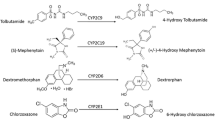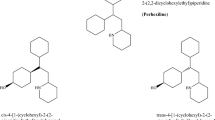Abstract
Hepatic NADPH-cytochrome P450 oxidoreductase null (HRN™) mice exhibit normal hepatic and extrahepatic biotransformation enzyme activities when compared to wild-type (WT) mice, but express no functional hepatic cytochrome P450 activities. When incubated in vitro with [14C]-diclofenac, liver microsomes from WT mice exhibited extensive biotransformation to oxidative and glucuronide metabolites and covalent binding to proteins was also observed. In contrast, whereas glucuronide conjugates and a quinone-imine metabolite were formed when [14C]-diclofenac was incubated with HRN™ mouse liver, only small quantities of P450-derived oxidative metabolites were produced in these samples and covalent binding to proteins was not observed. Livers from vehicle-treated HRN™ mice exhibited enhanced lipid accumulation, bile duct proliferation, hepatocellular degeneration and necrosis and inflammatory cell infiltration, which were not present in livers from WT mice. Elevated liver-derived alanine aminotransferase, glutamate dehydrogenase and alkaline phosphatase activities were also observed in plasma from HRN™ mice. When treated orally with diclofenac for 7 days, at 30 mg/kg/day, the severities of the abnormal liver histopathology and plasma liver enzyme findings in HRN™ mice were reduced markedly. Oral diclofenac administration did not alter the liver histopathology or elevate plasma enzyme activities of WT mice. These findings indicate that HRN™ mice are valuable for exploration of the role played by hepatic P450s in drug biotransformation, but poorly suited to investigations of drug-induced liver toxicity. Nevertheless, studies in HRN™ mice could provide novel insights into the role played by inflammation in liver injury and may aid the evaluation of new strategies for its treatment.




Similar content being viewed by others
Abbreviations
- ABT:
-
1-Aminobenzotriazole
- HRN™:
-
Hepatic cytochrome P450 reductase null mice
- WT:
-
Wild-type C57BL6 J mice
- P450:
-
Cytochrome P450
- NADPH:
-
Reduced nicotinamide adenine dinucleotide phosphate
- UDPGA:
-
Uridine 5′-diphospho-glucuronic acid
- ALT:
-
Alanine aminotransferase
- AST:
-
Aspartate aminotransferase
- GLDH:
-
Glutamate dehydrogenase
- ALP:
-
Alkaline phosphatase
- NAFLD:
-
Non-alcoholic fatty liver disease
References
Alkhouri N, Dixon LJ, Feldstein AE (2009) Lipotoxicity in nonalcoholic fatty liver disease: not all lipids are created equal. Expert Rev Gastroenterol Hepatol 3:445–451
Boelsterli UA (2003) Diclofenac-induced liver injury: a paradigm of idiosyncratic drug toxicity. Toxicol Appl Pharmacol 192:307–322
Boelsterli UA, Ramirez-Alcantara V (2011) NSAID acyl glucuronides and enteropathy. Curr Drug Metab 12:245–252
Boelsterli UA, Redinbo MR, Saitta KS (2013) Multiple NSAID-induced hits injure the small intestine: underlying mechanisms and novel strategies. Toxicol Sci 131:654–667
Claria J, Titos E (2004) Kupffer cell. Gastroenterol Hepatol 27:264–273
Day SH, Mao A, White R, Schulz-Utermoehl T, Miller R, Beconi MG (2005) A semi-automated method for measuring the potential for protein covalent binding in drug discovery. J Pharmacol Toxicol Methods 52:278–285
Dunk AA, Walt RP, Jenkins WJ, Sherlock SS (1982) Diclofenac hepatitis. Br Med J (Clin Res Ed) 284:1605–1606
Elcombe CR, Odum J, Foster JR, Stone S, Hasmall S, Soames AR, Kimber I, Ashby J (2002) Prediction of rodent nongenotoxic carcinogenesis: evaluation of biochemical and tissue changes in rodents following exposure to nine nongenotoxic NTP carcinogens. Environ Health Perspect 110:363–375
Ferre N, Claria J (2006) New insights into the regulation of liver inflammation and oxidative stress. Mini Rev Med Chem 6:1321–1330
Gan TJ (2010) Diclofenac: an update on its mechanism of action and safety profile. Curr Med Res Opin 26:1715–1731
Gutthann SP, Garcia Rodriguez LA, Raiford DS (1997) Individual nonsteroidal antiinflammatory drugs and other risk factors for upper gastrointestinal bleeding and perforation. Epidemiology 8:18–24
Henderson CJ, Otto DM, Carrie D, Magnuson MA, McLaren AW, Rosewell I, Wolf CR (2003) Inactivation of the hepatic cytochrome P450 system by conditional deletion of hepatic cytochrome P450 reductase. J Biol Chem 278:13480–13486
Hickey EJ, Raje RR, Reid VE, Gross SM, Ray SD (2001) Diclofenac induced in vivo nephrotoxicity may involve oxidative stress-mediated massive genomic DNA fragmentation and apoptotic cell death. Free Radic Biol Med 31:139–152
Kalgutkar AS, Soglia JR (2005) Minimising the potential for metabolic activation in drug discovery. Expert Opin Drug Metab Toxicol 1(1):91–142 Review
Lorbek G, Lewinska M, Rozman D (2012) Cytochrome P450s in the synthesis of cholesterol and bile acids-from mouse models to human diseases. FEBS J 279:1516–1533
Miyamoto G, Zahid N, Uetrecht JP (1997) Oxidation of diclofenac to reactive intermediates by neutrophils, myeloperoxidase, and hypochlorous acid. Chem Res Toxicol 10(4):414–419
Mizuno H, Sakamoto C, Matsuda K, Wada K, Uchida T, Noguchi H, Akamatsu T, Kasuga M (1997) Induction of cyclooxygenase 2 in gastric mucosal lesions and its inhibition by the specific antagonist delays healing in mice. Gastroenterology 112:387–397
Mutch DM, Klocke B, Morrison P, Murray CA, Henderson CJ, Seifert M, Williamson G (2007) The disruption of hepatic cytochrome p450 reductase alters mouse lipid metabolism. J Proteome Res 6:3976–3984
Park B-J, Lee Y-J, Lee H-L (2014) Chronic liver inflammation: clinical implications beyond alcoholic liver disease. World J Gastroenterol 20:2168–2175
Perez-Estrada LA, Malato S, Gernjak W, Aguera A, Thurman EM, Ferrer I, Fernandez-Alba AR (2005) Photo-fenton degradation of diclofenac: identification of main intermediates and degradation pathway. Environ Sci Technol 39(21):8300–8306
Pickup K, Gavin A, Jones HB, Karlsson E, Page C, Ratcliffe K, Sarda S, Schulz-Utermoehl T, Wilson I (2012) The hepatic reductase null mouse as a model for exploring hepatic conjugation of xenobiotics: application to the metabolism of diclofenac. Xenobiotica 42:195–205
Planaguma A, Claria J, Miquel R, Lopez-Parra M, Titos E, Masferrer JL, Rodes V, Arroyo J (2005) The selective cyclooxygenase-2 inhibitor SC-236 reduces liver fibrosis by mechanisms involving non-parenchymal cell apoptosis and PPARgamma activation. Faseb J 19:1120–1122
Purcell P, Henry D, Melville G (1991) Diclofenac hepatitis. Gut 32:1381–1385
Ramirez-Alcantara V, LoGuidice A, Boelsterli UA (2009) Protection from diclofenac-induced small intestinal injury by the JNK inhibitor SP00125 in a mouse model of NSAID-associated enterophathy. Am J Physiol Gastrointest Liver Physiol 297:G990–G998
Salama A, Kroll H, Wittmann G, Mueller-Eckhardt C (1996) Diclofenac-induced immune haemolytic anaemia: simultaneous occurrence of red blood cell autoantibodies and drug-dependent antibodies. Br J Haematol 95:640–644
Sarda S, Page C, Pickup K, Schulz-Utermoehl T, Wilson I (2012) Diclofenac metabolism in the mouse: novel in vivo metabolites identified by high performance liquid chromatography coupled to linear ion trap mass spectrometry. Xenobiotica 42:179–194
Seitz S, Boelsterli UA (1998) Diclofenac acyl glucuronide, a major biliary metabolite, is directly involved in small intestinal injury in rats. Gastroenterology 115:1476–1482
Shipkova M, Armstrong VW, Oellerich M, Wieland E (2003) Acyl glucuronide drug metabolites: toxicological and analytical implications. Ther Drug Monit 25(1):1–16
Stiborova M, Arlt VM, Henderson CJ, Wolf CR, Kotrbova V, Moserova M, Hudecek J, Phillips DH, Frei E (2008) Role of hepatic cytochromes P450 in bioactivation of the anticancer drug ellipticine: studies with the hepatic NADPH:cytochrome P450 reductase null mouse. Toxicol Appl Pharmacol 226:318–327
Usui T, Mise M, Hashizume T, Yabuki M, Komuro S (2009) Evaluation of the potential for drug-induced liver injury based on in vitro covalent binding to human liver proteins. Drug Metab Dispos 37:2383–2392
Wang XJ, Chamberlain M, Vassieva O, Henderson CJ, Wolf CR (2005) Relationship between hepatic phenotype and changes in gene expression in cytochrome P450 reductase (POR) null mice. Biochem J 388:857–867
Wheeler MD (2003) Endotoxin and Kupffer cell activation in alcoholic liver disease. Alcohol Res Health 27:300–306
Zhu Y, Zhang QY (2012) Role of intestinal cytochrome P450 enzymes in diclofenac-induced toxicity in the small intestine. J Pharmacol Exp Ther 343:362–370
Acknowledgments
We thank Jonathan Greenall, Elizabeth Johnson and Peter Cotton for their excellent technical assistance, James Noakes for directing the in vivo study and Marie South for statistical advice.
Conflict of interest
The authors declare no conflicts of interest.
Ethical standard
The manuscript does not contain clinical studies or patient data.
Author information
Authors and Affiliations
Corresponding author
Electronic supplementary material
Below is the link to the electronic supplementary material.
Rights and permissions
About this article
Cite this article
Akingbasote, J.A., Foster, A.J., Wilson, I. et al. Hepatic effects of repeated oral administration of diclofenac to hepatic cytochrome P450 reductase null (HRN™) and wild-type mice. Arch Toxicol 90, 853–862 (2016). https://doi.org/10.1007/s00204-015-1505-x
Received:
Accepted:
Published:
Issue Date:
DOI: https://doi.org/10.1007/s00204-015-1505-x




